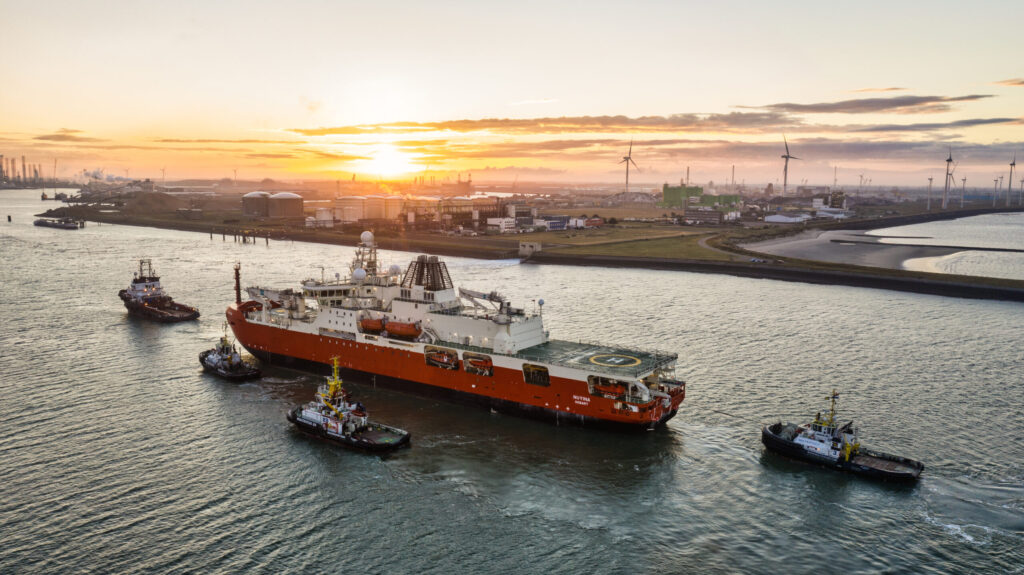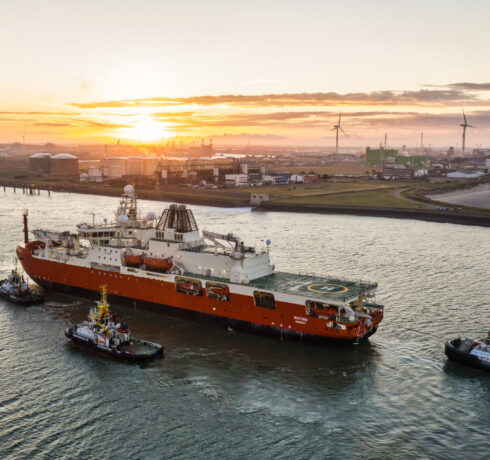Since August 29, the icebreaker RSV Nuyina has been on the quayside in Vlissingen-Oost. The ship is 99 percent ready.
Nuyina was scheduled to undergo commissioning and some final tests at Damen Shipyards Galati, but these were delayed due to the Covid-19 pandemic. By towing the nearly completed ship to Vlissingen, the work that still had to be carried out could be put back on schedule.
It was an emergency, but this was the best solution, according to Production Coordinator Arend van Veelen and Engineer Michiel Schittekat in their office in Vlissingen-Oost. Due to the corona crisis, international suppliers were unable to reach the yard in Galati, or at least experienced great difficulty in doing so. The project management in Vlissingen therefore decided, in July, after careful consideration, to relocate Nuyina to Vlissingen, and to continue commissioning the Antarctic Supply & Research Vessel (ASRV) there. Relocating the ship to Vlissingen made it easier for suppliers to continue their work.
The ship departed the Romanian shipyard on 3 August. Sailing via the Black Sea, Mediterranean Sea, Bay of Biscay and North Sea, she arrived in Vlissingen on 29 August after a journey of 6,800 kilometres. She did not sail under her own power, but was towed, because according to international regulations, a new ship that has not yet passed all the tests is not allowed to sail on its own propulsion in international waters.
It was a challenge to prepare the facilities and organisation for the arrival of the ASRV in a very short period of time, in the middle of the summer. Offices, staff and resources had to be ready to start preparing the ship immediately upon arrival.

According to schedule, RSV Nuyina will now start seatrials in the North Sea in the coming months. Quite a special situation, Arend and Michiel agree. If corona had not broken out, the 160-metre long vessel would have been put into operation in Romania and would also have completed sea trials there, on the Black Sea.
It would then have come to Vlissingen afterwards, but only as a working ship, to finish any residual points.
Now, RSV Nuyina – the name is from the Palawi Kani Tasmanian Aboriginal language meaning Southern Lights, Aurora Australis – will soon sail from Vlissingen-Oost to her home port Hobart in Tasmania, a trip of no less than 25,000 kilometres that takes eight weeks.
The vessel will serve as a supply ship for the Australian Antarctic Division of the Ministry of the Environment for the Australian Government’s research stations spread across Antarctica. In addition, she is equipped with state-of-the-art technologies for conducting scientific research in the region as part of the Australian Antarctic Programme.

Arend and Michiel would like to show us around on board the icebreaker, which has taken shape over the past three years. The ship has a striking reddish-orange colour. They call that international rescue orange, Michiel explains. It is a colour that stands out in polar regions.
Wandering through the gigantic ship, you notice how much technology has gone into it. Scientific studies are carried out on and below sea level from the entire aft deck below the helideck. The ship also has rooms with modern furnishings where scientists will soon be working behind the computer on the results of those investigations …
The cabins for the crew – Nuyina has 150 sleeping places – are spacious and comfortably furnished and all have a window. The bridge of the ship is colossal and has bridge wing windows in the floor on both sides, so that you can look straight into the water. This is very handy for manoeuvring, Arend knows. Right under the bridge is another observation bridge, a nice word for a space to relax in or to observe the ice mass in Antarctica for the scientists.
Two impressive cranes on the foredeck, each able to lift 55 tonnes, plus a 15-tonne crane on the aft deck, ensure that Nuyina can easily lift provisions and goods on board, intended for the people who work at the research stations and who assist in the modernisation programme of the South Pole stations.
With special, agile orange tenders, they can be picked up or put ashore at the often very remote stations in Antarctica and Macquarie Island, located south of Tasmania.
Nuyina is a ship to be proud of, say Arend van Veelen and Michiel Schittekat.
The icebreaker is scheduled to make her maiden voyage to the South Pole in the autumn of 2021.
But everyone in Hobart already knows the ship, Michiel knows. “The residents of that city talk about it in the street and in the café and are really looking forward to her arrival, we are all working on that at the moment.”

